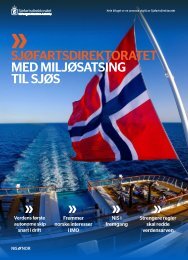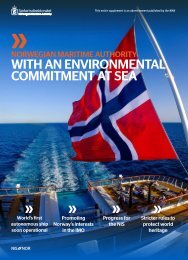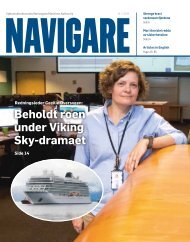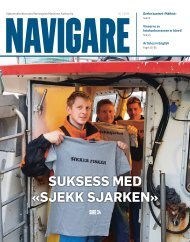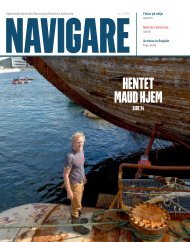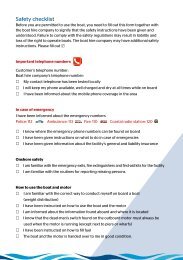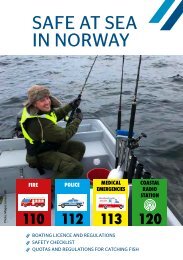Navigare 3 - 2019
You also want an ePaper? Increase the reach of your titles
YUMPU automatically turns print PDFs into web optimized ePapers that Google loves.
news<br />
employees on ships<br />
Risk = probability X consequence<br />
Consequence<br />
Probability<br />
Considerably low = 1<br />
0–2 %<br />
Low = 2<br />
2–5 %<br />
Moderate = 3<br />
5–10 %<br />
High = 4<br />
>10 %<br />
Negligible = 1 Substantial = 2 Significant = 3<br />
Acceptable risk<br />
(1)<br />
Acceptable risk<br />
(2)<br />
Acceptable if<br />
compensated<br />
(3)<br />
Acceptable if<br />
compensated<br />
(4)<br />
Acceptable risk<br />
(2)<br />
Acceptable if<br />
compensated<br />
(4)<br />
Acceptable if<br />
compensated<br />
(6)<br />
Not acceptable<br />
(8)<br />
Acceptable if<br />
compensated<br />
(3)<br />
Acceptable if<br />
compensated<br />
(6)<br />
Not acceptable<br />
(9)<br />
Not acceptable<br />
(12)<br />
The Regulations on medical<br />
examination of employees on<br />
Norwegian ships and mobile<br />
offshore units regulate health<br />
requirements for employees<br />
working on board Norwegian<br />
vessels. The purpose of health<br />
requirements is set out in section<br />
1:<br />
“These Regulation shall ensure<br />
that any person working on board<br />
a Norwegian ship or mobile<br />
offshore unit is medically fit for<br />
service on board, is not suffering<br />
from one or more medical<br />
conditions likely to be aggravated<br />
by service at sea or to endanger<br />
the health and safety of other<br />
persons on board”.<br />
board and for a safe operation of the vessel.<br />
This may for example imply that the risk is<br />
high if the consequences are significant, even<br />
though the probability is low.<br />
The appellate body will assess each case to<br />
find any compensating measures to be<br />
employed in order to reduce the risk. Examples<br />
of compensating measures could be using a<br />
hearing aid, installing additional alarms in<br />
cabins, reducing work tasks or safety tasks,<br />
putting limitations on trade areas, implementing<br />
an obligation to inform the captain or the<br />
company, etc. The obligation to inform the<br />
captain is important since the captain has the<br />
executive responsibility for medical treatment<br />
and safety on board.<br />
If an employee does not satisfy the health<br />
requirements and he/she wants to apply for<br />
exemption from the legislation, the appellate<br />
body will most likely impose restrictions in the<br />
medical certificate if an exemption is granted.<br />
Such restrictions may depend on the position,<br />
e.g. two people must always be on watch, or<br />
one person cannot have any safety functions on<br />
board. If it is possible to organise the work on<br />
board in a different manner and this has been<br />
discussed with the employer prior to the<br />
application and a statement from the employer<br />
is included in the application, this will be<br />
favourable in order to reach the right conclusion<br />
at the appellate body.<br />
Knowledge and correct use of the legislation<br />
as well as proper documentation of the health<br />
condition and workplace are important factors<br />
when determining if an employee should<br />
continue to work on a ship after being<br />
diagnosed with an illness or health issue.<br />
In some cases, it is more important to<br />
document the functional ability than the actual<br />
health condition. The best way to test the<br />
functional ability is to work, provided that the<br />
employee is medically fit for it. We often see<br />
that employees at sea are passively waiting for<br />
the health requirements to be met. If it is<br />
possible to get alternative work on shore during<br />
such waiting periods, this would help<br />
determining the functional ability. It is rarely an<br />
option for seafarers to return to work gradually<br />
by means of graded sickness benefit (partial sick<br />
leave). It is important to talk to your treating<br />
physician if alternative work on shore is an<br />
option. This should also be discussed with<br />
NAV (the Norwegian Labour and Welfare<br />
Administration).<br />
The Regulations on medical examination<br />
of employees on Norwegian ships and mobile<br />
offshore units are drawn up to help maintain<br />
safety on board. However, it is in everyone›s<br />
interest to find the best solutions possible in<br />
order for employees to keep their job on<br />
board a ship by means of adjustments, etc. as<br />
long as it is safe and their health condition<br />
does not present a safety risk on board.<br />
There has been limited research on how<br />
important health requirements are to safety<br />
on board. How many of the seafarers who<br />
have been found unfit for duty have had<br />
symptoms after the decision has been made,<br />
that could potentially have caused serious<br />
incidents on board? And how many of the<br />
serious incidents that have occurred on<br />
board Norwegian vessels may have been<br />
caused by known illnesses? We are trying to<br />
find answers to these questions. The<br />
Norwegian Centre for Maritime and Diving<br />
Medicine is working to establish a health<br />
register. We would like to get involved in<br />
research to extend our knowledge and create<br />
a professional basis for the health<br />
requirements and targeted strategies of the<br />
future.<br />
<strong>Navigare</strong> 3 - <strong>2019</strong> | 65










